|
Blake’s Seamaster, Straddle Bug(ing), a Champion
of yachts large and small and the dreary port of Surrender!
Designed for polar exploration by French naval architects, Luc Bouvet and Olivier Petit, the 36m long, aluminium-hulled schooner as Seamaster became famous under the ownership of the late Sir Peter Blake’s Blakexpeditions company, and sadly will be forever identified as being the vessel on which the legendary New Zealander was fatally shot. It happened in early December 2001 while Seamaster while moored near Matapo at the exit of the Amazon river in Brazil and she was boarded by thugs. Charles Sells of Plymouth, England produced a fine RC model (seen in a series of photos above and below).
Built at 1:28 full size scale by Sells as Cousteau’s Antarctic Explorer for Richard Howard of England who has a large collection of sailing models, he produced the model from plans drawn by Francois Couture, the model coming out at 51” in length. Highly detailed with many parts including the deck edge rails made of brass, Charles Sells who is an avid modeller and model sailor achieved acclaim for the completed model of a boat that is still dear to the hearts of New Zealanders, but in other ways, a sad reminder of Sir Peter Blake’s exit from this world.
| Highly detailed the model is beautifully finished |
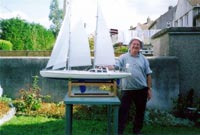 |
Charles Sell and the completed model. |
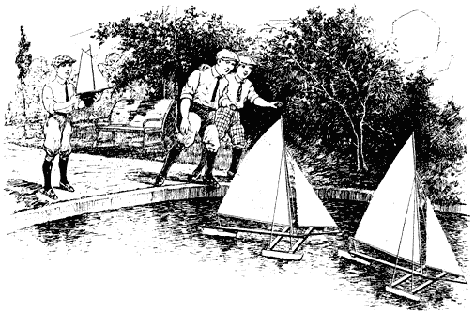
Earl (Boebert) included an interesting article in the Winter 2007 issue of The Model Yacht that shows again how wide and varied are the types of model yacht areas of activity in giving information of a boat known as a `Straddle Bug’ – an over-simplified example of a sailing model designed by William Atkin, NA one of the most prolific designers of the first half of the Twentieth Century.. Now I’m no Entomologist but I can attest to having seen more than a few Stick Insects in my life, particularly back in time and place (my homeland, Guyana) and this double-hulled boat (seen being enjoyed in the engraving above) rode on two short pontoons up forward and one in its centre located aft, save for the mainsail and jib has definite visual characteristics to a floating stick insects. Perhaps this iceboat-type freesail boat, the plan of which appeared in an issue of Popular Mechanics in 1925 was indeed inspired by a stick insect of some sort. The fact that Atkin and his co-designer son and design partner, John chose to include the word `bug’ in its name may even be a clue, but that however is pure conjecture on my part. Few tools are required and there is no tedious shaping and carving to be done on a hull, if the simple framework can be called by that name. It requires just three pieces of pine 3/8 of an inch thick by 1 ¼ “ wide. A boat for calm, flatwater sailing I’d suggest. A simple to make model, very economical in cost and very `different’ and one that I suggest would be on the fast side, though it might be prone to capsize. What a temptation to build one and name it Shtick em Up!

A legend in his own time
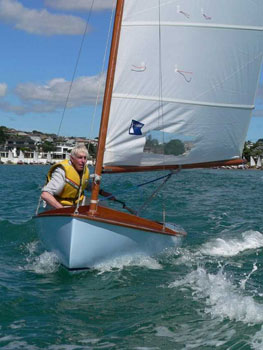
Des Townson passed away October 15th, 2008 after an illness |
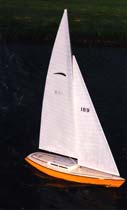 |
All Electrons at Onepoto (below)
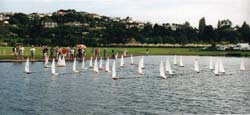
A New Electron is launched (left) |
A fleet on the sands of Toberua Island, Fiji (below)
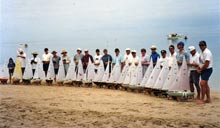 |
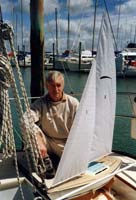 |
| Aboard Talent with Electron (right) |
He is a living yachting legend in New Zealand, Des Townson, and in the Government of this nations list of honours announced in June, to people who have made significant contributions in various areas of New Zealand life, this friend of many was awarded an MNZM, a member of the New Zealand Order of Merit. A big boat designer and builder, a sailor who still enjoys going out for a few days at a time aboard a boat he built, the Townson 34‘ Talent and in between works diligently in his home workshop hand producing his little Townson `Electron’ RC boats, one thousand and fourteen made to date over a period of twenty years. An honourable and most approachable and helpful gentleman, and above all a good citizen, Des has always been a great supporter of the writer’s model yachting efforts and I have a wonderful memory of he and I sharing a bure at Toberua Resort in the Fiji Islands some years ago when his little `Electron yachts were sailed in a regatta there. On another occasion he insisted on lending me Bluebell, one of his demonstration models, to take over and sail myself the following year.
In his younger years he won the prestigious holy grail of New Zealand P Class yachting (the Tanner Cup) in a boat called Vanity, and as a Champion of `one design’ his Mistrals, Starlings and Darts were all stepping stones into the keeler world where he further made his mark.. I am immensely proud of our association and friendship and I salute his achievement.
TIME is a versatile performer indeed, It flies, marches on, heals all
wounds, runs out and will `tell’.
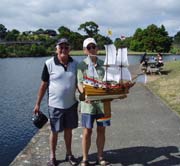 |
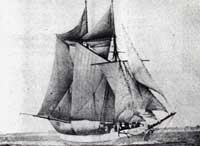 |
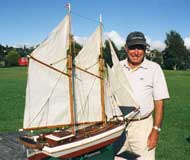 |
It was nice to finally meet our Publisher, Chuck, and his wife Sandra when they visited New Zealand in late January this year. They visited our sailing pond, Onepoto and met a few of our Ancient Mariners. Why we even got Chuck to have a go (his first ever!) at RC model sailboating, photographic evidence in the top left image. In the top right photograph is the old New Zealand scow Herald built in 1898. In 1928 she hit Canoe Rock in Auckland’s Hauraki Gulf and without a crew sailed away never to be seen again. Not so really, for old fishermen in the dead of night swore that they had nearly been run down by an eerie old scow with no sign of anyone on board and that is the legend of Herald. New Zealand trading scows make wonderful subjects for sailing models, one of the nicest (seen in the above photograph with Murray White) being his Alma occasionally sailed with the Ancient Mariners in Auckland.
To the point of near Surrender |
`I have done some truly forgettable `voyages’ on the internet in my early days of producing Windling World magazine. You see, in cruising parlance, the route by sea to Cleverness is often through Confusion Canal where one must hugthe craggy, far from precisely defined let alone clearly charted coast of Gobbledegook leading to the Sea of Exasperation, and for some, eventual voyage abandonment at the dreary, depressing port of Surrender. where the tourist authority advises…`it is best not to have a loaded gun handy!’
Recurring computer problems early this year prompted the above memory recall and I have to confess that I came perilously close to flying the white flag of surrender. `Oscar Hoodwink’, my computer,though much younger than I am is getting old and at my age and stage of life I am no longer prepared to shell out several thousand bucks just to produce new columns while contributing to some computer company’s surge towards prosperity. Anyway I am still here (though this is written well in advance) and Where the winds blow… well if you are reading this, suffice to say the winds are still blowing!
`My mind not only wanders – it sometimes leaves
completely,
particularly in bed at night when it slips
anchor and heads out to sea,
ends up in Tierra del
Fuego
which is a long way from New Zealand!’
On the Mary J Ward
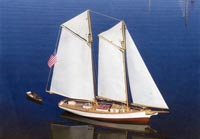 |
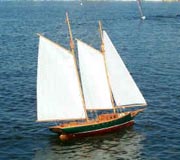
Photos by Mark Johnson |
For those who fall into the category of persons with a genuine love of schooners, particularly those of vintage style who haven’t the patience or the ability to scratch build one without `going bananas’ in the process, then maybe, just maybe, Victor Model Products’ model that I am going to tell you about should be seriously considered. Modelled loosely or faithfully (I tend to suggest the latter) on the Mary J Ward, a small American inshore fishing schooner of the late 1880’s and presented in kit form, the MJW model (several shown above) when built comes out at a length of 34” (41” with bowsprit and in my eyes is a downright sexy and faithfully reproduced schooner of the period. The original boat was built in Essex, Massachusetts and her history tells us that she was once credited with outsailing the fast Boston Pilot boat Hesper. Victor operate out of Downey in California, producing some twenty different model sailboats. When asked, George Dornis of Victor told me that to date 200 of the schooners have been sold, the largest fleets of them are in Florida and there are MJW schooners currently being built in both Britain and Australia. No sign yet of one in New Zealand.
An Englishman in Wisconsin
Graham McAllister, an Englishman with a Scottish name, believe it or not, and resident these days in Sheboygan County in the State of Wisconsin, USA, is producing two current kits of Footy model yachts that he designed himself. The Kittiwake K2 is one of them, the other being the lug sail Pintail.
The key thing about Graham’s boats is the foam core hull construction method which makes building them very easy and adds flotation that makes them (I am told) virtually unsinkable. His `company’ (I suppose you could call it that) is Scalesailing and his email is scalesailing@sbcglobal.net.
I have also got a photograph of a gaff-rigged version of the Pintail that I think you will agree looks really nice. I don’t go into prices and you can email him and get full details. Meanwhile, the following four photos show the builder, the level of enthusiasm in the Footy at a Wisconsin regatta and the K2 and Pintail lug and gaff-rigged versions.
`Were I a builder and one I’m not (and I’m not because I can’t!)
I’ve seen a boat that I would build, but since I can’t…I shan’t.
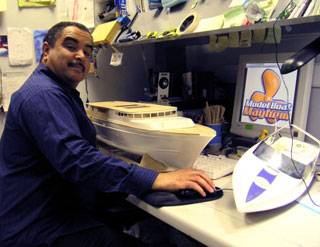 |
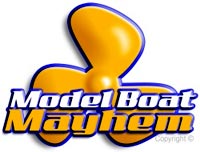 |
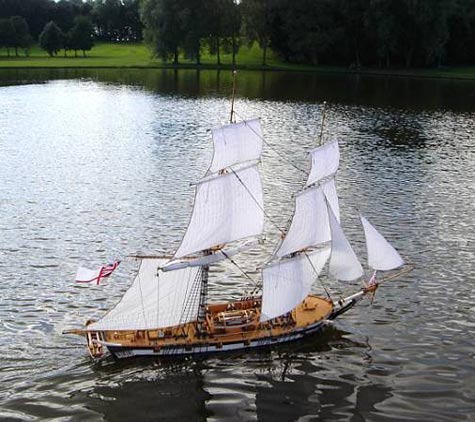
Above is Martin Davis (originally of Jamaica) who some four years ago set up MODEL BOAT MAYHEM, an independent model boat website on the internet, a site that although mainly covering power boats does include those under sail. Light-hearted, it fills a need for all grown men and women who enjoy building and playing with model boats. Visitors to the website have increased dramatically and today there is an active membership of over 2,000, but most important it is totally free to those who visit. A power boat and model speedboat enthusiast, Martin is helped by his colleague who simply goes by the name of “Bradders’. Although it is principally on powered boats it is really worth visiting, so just punch in `Model Boat Mayhem’ and your search engine will do the rest. In the third photograph above, no connection, (wait a moment, it was on Martin’s website that I found and with his help made contact with Brian Clark, the builder of HMS Killingworth seen under sail).
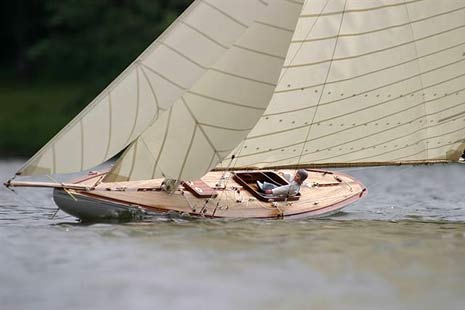
An absolutely beautiful William Fife designed yacht (above), Lucky Girl built by Gisela and Helmut Scharbaum of Germany, the photo captured by modelmaker and lensman, Hans Staal. The model took 1300 hours to build and was first sailed in 2004, The original boat was also named Lucky Girl after the 3 year old daughter of the original owner, a Mr Tallberg who in 1924 sailed the same yacht to win the bronze medal for Finland in the Olympics.
|
Good Grief, where has year 2008 gone, well there’s not much of it left is there? By the way , I wonder how many have heard of the Bitchen Chicks Yacht Club formed in 1997 in the US by a group of women? It says it is focussed on frivolity and fun and it’s a novel idea, but each time I try to visit their website, doing so tends to stuff up my computer and I have to `eject!’. (There must be some bitchin going on!) Here we are almost into another celebration of Christmas, where for us in the antipodes it is Summer., and there ends yet another column of mine for those who love model sailboats.
|

